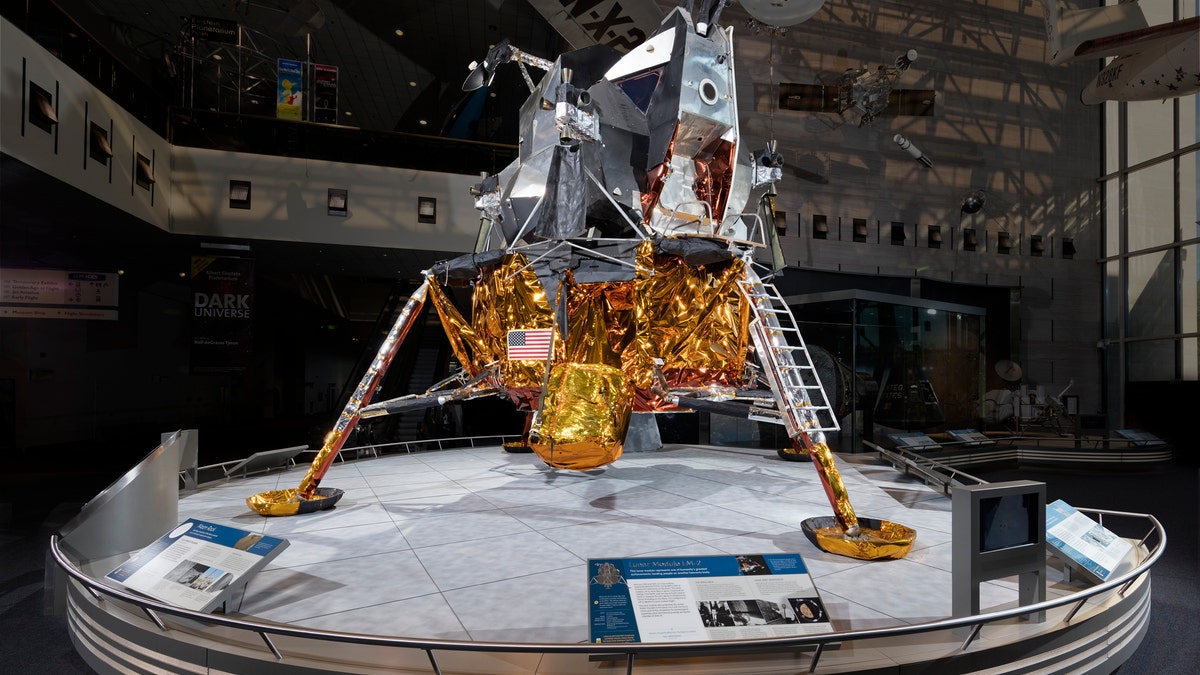
The Lunar Module LM-2 at the Smithsonian National Air and Space Museum. (Smithsonian National Air and Space Museum)
If it wasn’t for the lunar module, we wouldn’t have heard the famous words from Neil Armstrong, on July 20th of 1969.
“That's one small step for [a] man, one giant leap for mankind.”
Neil Armstrong uttered those famous words after stepping off from the descent stage of the Eagle, Apollo 11’s lunar module. The descent stage remains on the Moon, a permanent reminder of Armstrong and Buzz Aldrin’s almost 22-hour stay on Earth’s natural satellite. While Eagle was on the lunar surface, the Columbia Command Module, piloted by Michael Collins, was orbiting 60 miles above them.
APOLLO 11: NEIL ARMSTRONG'S GOLD MEDAL THAT FLEW TO THE MOON SOLD FOR MORE THAN $2 MILLION
Eagle’s ascent stage safely transported Armstrong and Aldrin back to Columbia and was later jettisoned.
The Smithsonian National Air and Space Museum has Lunar Module 2 in its collection. The module, which was used for ground testing before the Apollo 11 mission, doesn’t even look like it would fly.
“It was designed for purpose,” said Cathleen Lewis, curator at the Museum’s space history division “It didn't need to re-enter the atmosphere, didn't need to fly through the air or even return to earth.”
APOLLO 11 ASTRONAUT MICHAEL COLLINS RECALLS DRINKING COFFEE DURING 'LONELY' MOON LANDING ORBIT
But the module was created to withstand conditions outside Earth’s atmosphere. “The materials that are used are very good for flying into space for a very short period of time and they don't last very long here on Earth full gear gravity in the sunlight,” Lewis said.
The biggest artifact from Apollo 11 is the Columbia Command Module, which falls under the oversight of Dr. Margaret A. Weitekamp, who curates the Museum's social and cultural dimensions of spaceflight collection.
She explained that Columbia is on a national tour. The Module is part of "Destination Moon: The Apollo 11 Mission," a traveling Smithsonian exhibit that is at the Museum of Flight in Seattle until Sept. 2, 2019.
APOLLO 11: SECRET NIXON SPEECH REVEALS WHAT WOULD HAPPEN IF ARMSTRONG AND ALDRIN COULDN'T COME BACK
But, the Smithsonian National Air and Space Museum is opening some of the Apollo 11 Moon rock samples for the first time. When the astronauts returned from the Moon, some of the rocks they brought with them were studied, whereas others were kept vacuum-sealed in anticipation of developments in analysis technology. On the 50th anniversary of the mission, they are now open for scientists to study as well.
One of the most exciting artifacts from Apollo 11 turned out to be in Armstrong’s bedroom. “Even the astronauts want a souvenir of this extraordinary work that they've done,” said Weitekamp. When he passed in 2012, the curators had an opportunity to go over his office. And there it was, up in the closet up in his bedroom, the camera that took the wonderful pictures we see today.
Half a century after the Moon landing, the event’s impact on society is so great that the expression “if we could send a man to the moon, why can't we …” has entered into the vernacular.
APOLLO 11: SECRET NIXON SPEECH REVEALS WHAT WOULD HAPPEN IF ARMSTRONG AND ALDRIN COULDN'T COME BACK
The mission serves as a reminder of mankind’s remarkable ability for technical innovation.
CLICK HERE TO GET THE FOX NEWS APP
Be sure to catch the America’s News HQ Apollo 11 50th anniversary special on Fox News on Saturday, July 20 at 12 PM EDT.




















